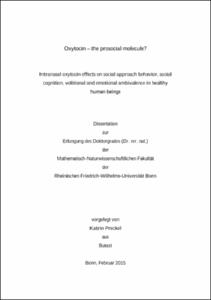Preckel, Katrin: Oxytocin – the prosocial molecule? : Intranasal oxytocin effects on social approach behavior, social cognition, volitional and emotional ambivalence in healthy human beings. - Bonn, 2015. - Dissertation, Rheinische Friedrich-Wilhelms-Universität Bonn.
Online-Ausgabe in bonndoc: https://nbn-resolving.org/urn:nbn:de:hbz:5n-41630
Online-Ausgabe in bonndoc: https://nbn-resolving.org/urn:nbn:de:hbz:5n-41630
@phdthesis{handle:20.500.11811/6548,
urn: https://nbn-resolving.org/urn:nbn:de:hbz:5n-41630,
author = {{Katrin Preckel}},
title = {Oxytocin – the prosocial molecule? : Intranasal oxytocin effects on social approach behavior, social cognition, volitional and emotional ambivalence in healthy human beings},
school = {Rheinische Friedrich-Wilhelms-Universität Bonn},
year = 2015,
month = oct,
note = {Oxytocin (OXT) is a highly conserved neuropeptide, regarding both its chemical structure and its functionality. It has been traced back at least 700 million years. OXT’s fundamental role lies in reproduction and parenting behavior. OXT findings in animal models, which provided the initial interest for OXT research in humans, are presented in this thesis to clarify the importance of biochemical mechanisms, sexual-dimorphism and species-specificity of the OXT system. In the past few years, OXT has become a very prominent molecule because it may improve social deficits, even in psychiatric illnesses, e.g. social phobia or schizophrenia. However, past research findings have produced highly controversial results in regard to OXT’s prosocial role, which might also be due to the complexity of the biochemical mechanisms which are still widely unknown. This dissertation examines modulatory influences of intranasal OXT on different social domains in healthy women and men to further distinguish the prosocial – and possibly beneficial – effects of this neuropeptide. The first study revealed prosocial effects of intranasal OXT in women, who selectively approached social positive stimuli quicker and more closely after OXT administration. In the second study, OXT was also found to have a prosocial effect. It increased the willingness to induce happy emotions, while it reduced the willingness to induce anger or fear. The willingness to induce positive, but not negative emotions, was accompanied by (for example) reduced or increased inferior frontal gyurs (IFG) activity, respectively. In the third study, OXT was indirectly investigated as a prosocial neuropeptide. The fMRI study revealed that OXT diminished neural activity in the dorsal anterior cingulate cortex (dACC) in response to volitional (Experiment 1) as well as emotional (Experiment 2) ambivalence. Behaviorally, the OXT effect was apparent in faster reaction times (Experiment 1) and reduced arousal ratings (Experiment 2). In conclusion, the results of the three presented studies indicate that OXT does primarily act as a prosocial molecule, however the prosocial tendencies of OXT may be tilted by many different moderators such as genetic predispositions, early life experiences or strong personality traits.},
url = {https://hdl.handle.net/20.500.11811/6548}
}
urn: https://nbn-resolving.org/urn:nbn:de:hbz:5n-41630,
author = {{Katrin Preckel}},
title = {Oxytocin – the prosocial molecule? : Intranasal oxytocin effects on social approach behavior, social cognition, volitional and emotional ambivalence in healthy human beings},
school = {Rheinische Friedrich-Wilhelms-Universität Bonn},
year = 2015,
month = oct,
note = {Oxytocin (OXT) is a highly conserved neuropeptide, regarding both its chemical structure and its functionality. It has been traced back at least 700 million years. OXT’s fundamental role lies in reproduction and parenting behavior. OXT findings in animal models, which provided the initial interest for OXT research in humans, are presented in this thesis to clarify the importance of biochemical mechanisms, sexual-dimorphism and species-specificity of the OXT system. In the past few years, OXT has become a very prominent molecule because it may improve social deficits, even in psychiatric illnesses, e.g. social phobia or schizophrenia. However, past research findings have produced highly controversial results in regard to OXT’s prosocial role, which might also be due to the complexity of the biochemical mechanisms which are still widely unknown. This dissertation examines modulatory influences of intranasal OXT on different social domains in healthy women and men to further distinguish the prosocial – and possibly beneficial – effects of this neuropeptide. The first study revealed prosocial effects of intranasal OXT in women, who selectively approached social positive stimuli quicker and more closely after OXT administration. In the second study, OXT was also found to have a prosocial effect. It increased the willingness to induce happy emotions, while it reduced the willingness to induce anger or fear. The willingness to induce positive, but not negative emotions, was accompanied by (for example) reduced or increased inferior frontal gyurs (IFG) activity, respectively. In the third study, OXT was indirectly investigated as a prosocial neuropeptide. The fMRI study revealed that OXT diminished neural activity in the dorsal anterior cingulate cortex (dACC) in response to volitional (Experiment 1) as well as emotional (Experiment 2) ambivalence. Behaviorally, the OXT effect was apparent in faster reaction times (Experiment 1) and reduced arousal ratings (Experiment 2). In conclusion, the results of the three presented studies indicate that OXT does primarily act as a prosocial molecule, however the prosocial tendencies of OXT may be tilted by many different moderators such as genetic predispositions, early life experiences or strong personality traits.},
url = {https://hdl.handle.net/20.500.11811/6548}
}






